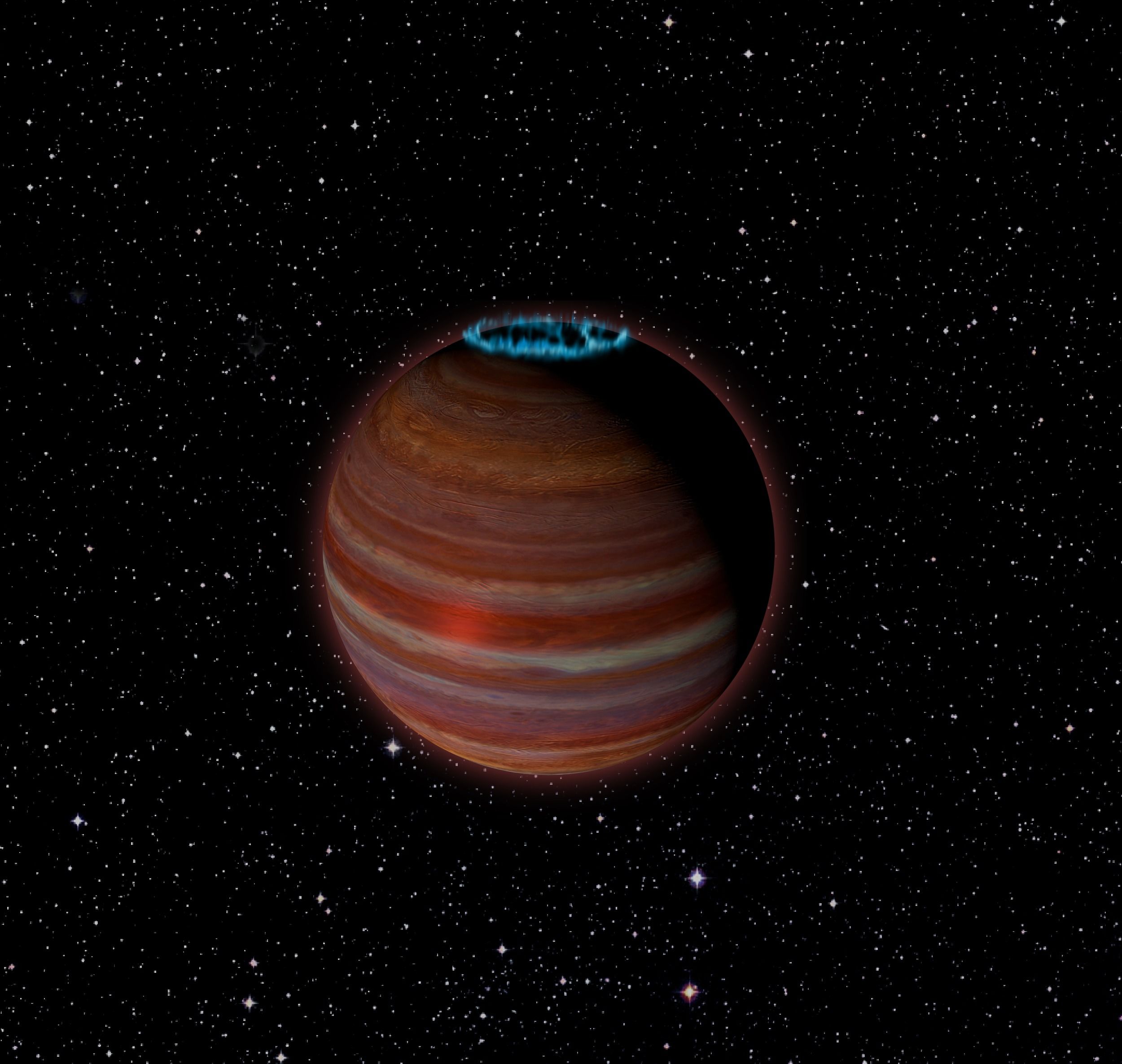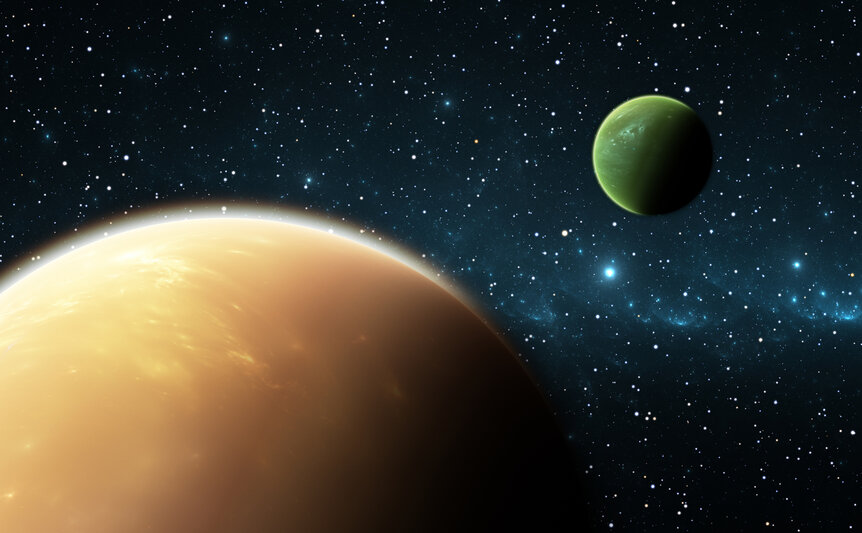Create a free profile to get unlimited access to exclusive videos, sweepstakes, and more!
An aurora glows over a (possible) rogue planet

Well now, this is interesting: Astronomers have detected radio wave emission from a planetary-mass object outside our solar system. This object may be a brown dwarf, but it’s possible it’s actually a rogue planet. Either way is cool, but what’s even cooler is that the emission may indicate the object has a moon or even a planetary-mass companion orbiting it!
The key to all this is magnetism. Stars can have magnetic fields, as can planets, and in both cases the basic physics is the same. In a nutshell, if you take a bunch of charged particles and move them around, they generate a magnetic field. In planets like Earth, molten iron in the outer core does the trick, creating a magnetic field as Earth spins and as the molten material rises and falls due to convection. In stars it’s more complicated, but the basic principle is the same.
The Sun has a ridiculously complex magnetic field. We know that dinky red dwarfs, stars that are lower mass, cooler, and fainter than the Sun, have them too. In fact, red dwarfs have so much material moving around inside them that their magnetism can be far stronger than the Sun’s, and more chaotic. Energy is stored in the magnetic field, and as these fields get tangled up they can snap, erupt, and blast out huge flares of energy.
But what about lower mass objects? There’s a whole class of objects called brown dwarfs which are more massive than planets but less than stars. Although the upper and lower limits are little fuzzy, they range roughly between 13 and 80 times the mass of Jupiter. More massive than that and they can fuse hydrogen in their cores, making them true stars.
The first brown dwarfs were found in the 1990s, and it wasn’t clear if their internal structure would allow them to have magnetic fields. But then some were detected flaring, getting much brighter in a specific wavelength (color) of light known to be from excited hydrogen. Your everyday brown dwarf doesn’t have the energy to do that, so, it’s reasoned, this increase in light must be due to magnetic flaring.
You’d expect radio wave emission from magnetic objects, too. For example, electrons spin around magnetic field lines, creating what’s called cyclotron radiation, and that can generate lots of radio wave energy. So astronomers pointed their radio telescopes at brown dwarfs known to flare in hydrogen, and boom! They started detecting them.
But this gets better. An aurora, like the northern lights on Earth, is caused by subatomic particles from the solar wind hitting the Earth’s magnetic field, which then channels them down into our atmosphere. They slam into molecules of nitrogen and oxygen, exciting them, and causing them to glow at characteristic colors (like green and red). Aurorae can emit radio wave energy, too, and — without getting into very complicated details — this type of emission can be isolated from just regular magnetic field radio wave emission.
Astronomers targeted five brown dwarfs known to emit both hydrogen light as well as radio waves, and found that four of them were emitting auroral radiation!
And this is where things get interesting indeed. One of their targets, called SIMP J01365663+0933473, was at first thought to be a massive brown dwarf, but a paper that came out in 2017 argued that it was part of a nearby group of young stars, called the Carina-Near group. These objects were all born around the same time, about 200 million years ago. We usually get the ages of brown dwarfs from their temperature and other characteristics, but this can be tricky; a young BD is hotter and can fool you into thinking it’s more massive than it is. In this case that’s what happened. SIMP J0136 is actually much lower mass and younger than thought before, and may only be about a dozen or so times the mass of Jupiter.
If that’s the case, it may not be a brown dwarf at all, but instead a rogue planet, literally a planet not orbiting a star! It may have formed alone in space, or been born with a star and subsequently ejected from the system, perhaps by a close encounter with another planet.
But either way, it’s isolated.
And that’s the very interestingest thing indeed. Remember, an aurora on Earth is caused by the solar wind. But the astronomers detected auroral radiation from SIMP J01236! If it’s isolated, where are the particles causing the aurora coming from?
Hmmmm. In our solar system, other planets have an aurora, too. Jupiter, for example, has a pretty strong aurora, and it’s only partially due to solar wind. It also interacts with its big moons (especially volcanic Io), stripping charged particles from them and funneling them down into its atmosphere.
This raises a very cool possibility: SIMP J0136 may have a companion, either a moon or a bigger, planetary mass object orbiting it! The powerful magnetic field from the brown dwarf (some 200 times Jupiter’s strength) may rip charged particles from the companion and greedily send them into the brown dwarf’s atmosphere, creating the aurora.
There’s also some advancement in basic science here, too. It’s thought that rapid rotation can aid the generation of a magnetic field, and many brown dwarfs with strong fields spin rapidly. Understanding how that works in detail is difficult, but finding more objects with good magnetic fields will help, as well as seeing how that ties in with the hydrogen emission. Not only that, but this can affect how we observe exoplanets; an aurora fluctuates, changing the brightness of a planet in a similar way that clouds can as the planet rotates. Distinguishing the two will help astronomers better examine exoplanetary atmospheres.
Not long after the first couple of brown dwarfs (Teide 1 and Gliese 229B) were discovered, I did some work on them; I was on the team for the Hubble Space Telescope camera STIS, and right after it was installed on board we used it to observe Gliese 229B. It wasn’t my observation; I was a support scientist, and an astronomer who was observing it asked me to help process the data (which turned out to be quite a thing due to some interesting optical effects, and while I was able to get his data in shape, it took months to write software to be able to do it automatically for any observation). That got me interested in brown dwarfs, and over the next few years I put in a lot of time trying to understand and observe them.
That’s why I love writing about them now as a science communicator. It’s not often you get to be right there when a new field of discovery opens up, and even though I’m not actively doing the science anymore, it fills me with pride and wonder when I get to read about what’s now on the cutting edge. I can see how far we’ve come.




























